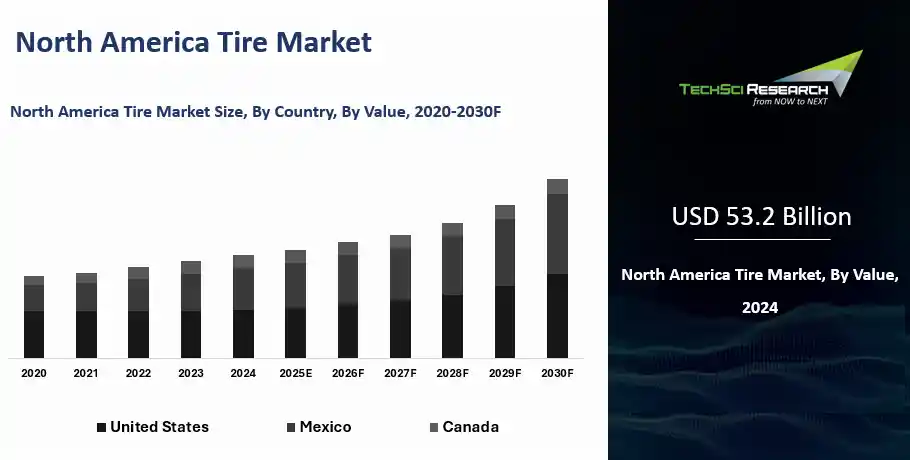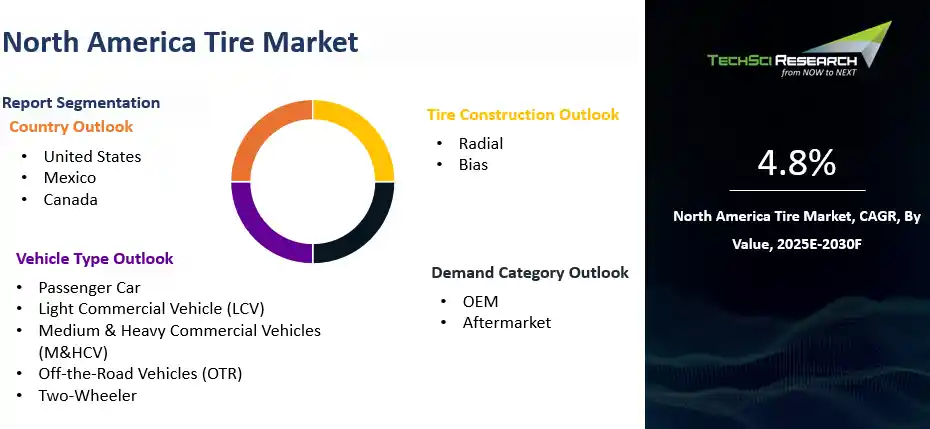|
Forecast Period
|
2026-2030
|
|
Market Size (2024)
|
USD 53.2 Billion
|
|
CAGR (2025-2030)
|
4.8%
|
|
Fastest Growing Segment
|
Aftermarket
|
|
Largest Market
|
United States
|
|
Market Size (2030)
|
USD 70.6 Billion
|
Market
Overview
The North America Tire Market
was valued at USD 53.2 Billion in 2024 and is projected to reach approximately USD
70.6 Billion by 2030, expanding at a CAGR of 4.8% during the forecast period of
2025–2030. The North America tire market is shaped by the intersection of
automotive innovation and evolving consumer expectations. Demand is surging
across both the OEM and aftermarket segments, with consumers seeking higher
durability, better fuel efficiency, and enhanced safety features. Technological
upgrades such as run-flat tires and low rolling resistance designs are
receiving increased traction due to performance and environmental benefits.
Evolving mobility trends, including ride-sharing and fleet expansion, further
reinforce tire consumption patterns in urban and intercity routes.
Emerging trends such as smart tire technologies are opening
opportunities for integrated vehicular intelligence. These tires, embedded with
sensors, offer real-time data on tread depth, temperature, and pressure,
helping reduce maintenance costs and road hazards. The integration of AI with
tire diagnostics and predictive analytics is expected to optimize tire life
cycle management and fleet operations. Opportunities are also rising in the
green tire segment, where sustainable raw materials and bio-based rubber blends
are gaining attention for their environmental compatibility. The market faces
challenges including fluctuating raw material prices and a high dependency on
synthetic rubber and oil-based inputs. Volatility in crude oil prices impacts
tire production costs, creating uncertainty in pricing strategies. Another
challenge lies in managing end-of-life tires, as tire disposal and recycling
regulations tighten. Rising import tariffs and supply chain disruptions
continue to influence operational costs and inventory availability, especially
in aftermarket distribution.
Market
Drivers
Expanding Automotive Fleet Size
The continuous rise in vehicle registrations across passenger and
commercial categories contributes significantly to tire demand. New vehicle
sales and a surge in second-hand vehicles have resulted in frequent tire
replacements. As mobility services and last-mile delivery networks grow, tire
consumption is expected to stay robust in both urban and rural transportation
sectors.
Growth in Tire Replacements and Maintenance Awareness
Increased consumer focus on vehicle maintenance and safety has led to
proactive tire replacements. With growing awareness about the effects of
worn-out tires on braking and fuel efficiency, consumers are opting for timely
tire changes. Retailers and digital platforms are also facilitating easier
access to tire options, enhancing market growth.
Technological Advancements in Tire Manufacturing
Tire manufacturers are investing in innovations such as self-healing
tires, lightweight materials, and noise-reduction technologies. These advancements
are improving the lifespan, comfort, and performance of tires under varying
road and weather conditions. Smart tires equipped with IoT sensors are gaining
acceptance in fleet management and performance tracking.
Surge in All-Season Tire Adoption
Consumers are increasingly preferring all-season tires due to their
year-round usability and cost efficiency. The ability to perform under diverse
climate conditions without frequent seasonal changes is making them an
attractive option for both individual vehicle owners and fleet operators. Online
tire sales are streamlining consumer access to multiple tire brands and models,
allowing for price comparisons and home delivery. The convenience of digital
purchase channels, supported by reviews, installation services, and warranty
information, is fueling sales in both urban and remote areas.

Download Free Sample Report
Key
Market Challenges
Volatile Raw Material Prices
Raw material costs, particularly for natural rubber, synthetic rubber,
and carbon black, are highly sensitive to global economic conditions and
geopolitical tensions. Price fluctuations impact production costs and lead to
margin pressures across the value chain, particularly for small and medium
players.
Environmental Regulations on Tire Disposal
Stringent environmental policies on tire waste and disposal are raising
compliance burdens. Tire manufacturers and retailers must invest in recycling
infrastructure and adopt sustainable practices. Inefficient disposal or burning
of tires poses ecological risks, prompting tighter legislative action.
Supply Chain Disruptions and Logistics Costs
Complex global supply chains are vulnerable to delays and increased
shipping costs due to port congestion, trade barriers, and geopolitical
conflicts. These disruptions affect the timely availability of raw materials
and finished products, impacting OEM and aftermarket operations alike.
Rising Competition from Low-Cost Imports
The influx of low-cost tire imports poses a threat to domestic
manufacturers. Price-sensitive customers are often drawn to cheaper
alternatives, which intensifies price competition and reduces brand loyalty.
Regulatory interventions such as anti-dumping duties are sometimes employed,
but challenges persist.
Technological Integration Costs
While smart and connected tire technologies offer competitive
advantages, integrating these systems into traditional manufacturing lines
requires significant investment. The cost of R&D, software development, and
workforce training can be prohibitive, especially for small-scale operations
trying to remain cost competitive.
Key
Market Trends
Growth of Smart Tires with Embedded Sensors
Tires with embedded sensors that monitor tire pressure, temperature, and
tread depth are gaining popularity. These smart tires provide real-time data to
drivers or fleet managers, enabling proactive maintenance and reducing the risk
of accidents or blowouts. The integration with telematics systems is reshaping
fleet management strategies.
Rising Demand for Sustainable and Green Tires
Tire manufacturers are developing sustainable alternatives by using
natural rubber blends, silica, and renewable oils. Consumers are becoming more
eco-conscious, pushing demand for low-rolling-resistance and energy-efficient
tires. Regulatory support for eco-friendly transportation is further
encouraging these innovations.
Focus on Lightweight and Fuel-Efficient Designs
Automotive OEMs are seeking tire solutions that reduce vehicle weight
and improve mileage. Lightweight tires contribute to reduced rolling
resistance, improved acceleration, and lower emissions. Manufacturers are
incorporating advanced materials like aramid and Kevlar to achieve these
efficiencies.
Integration of AI and Predictive Analytics in Tire Management
Artificial intelligence is being employed to analyze tire performance
data and predict maintenance schedules. Predictive analytics helps prevent
tire-related failures and reduces operational costs. This trend is particularly
valuable in commercial fleets where uptime is critical.
Rise in Customization and Performance-Based Tire Demand
Consumers are showing interest in performance tires suited to specific
driving needs such as off-road, high-speed, or winter conditions. The
customization trend allows buyers to choose tire specifications that match
their usage patterns, lifestyle, and aesthetic preferences.
Segmental
Insights
Vehicle Type Insights
The North America tire market is segmented by vehicle type into
passenger cars, light commercial vehicles, medium and heavy commercial
vehicles, two-wheelers, and off-the-road (OTR) vehicles. Tire
requirements vary significantly across these vehicle categories depending on
the load capacity, driving conditions, and usage intensity. Passenger car tires
are tailored for urban commuting and highway comfort, with an emphasis on fuel
efficiency, noise control, and seasonal adaptability. Light commercial vehicle
tires are engineered for last-mile deliveries and urban cargo transportation,
offering a balance between durability and fuel savings. Medium and heavy commercial vehicles operate in more demanding
environments, requiring tires capable of withstanding higher loads, extended
mileage, and all-weather conditions. These tires often feature reinforced
sidewalls, deeper treads, and enhanced puncture resistance. Two-wheeler tires are designed for maneuverability and grip in urban areas,
supporting quick acceleration and braking. This segment often Favors
cost-effective tire options that deliver reliability on variable road surfaces. OTR tires cater to construction, agriculture, and mining vehicles,
emphasizing traction, cut resistance, and longevity in extreme conditions. The
design of OTR tires includes unique tread patterns and robust casing structures
to perform efficiently in off-road terrains. Each vehicle category shapes tire
performance expectations and influences purchasing decisions across both
replacement and original equipment sectors.

Download Free Sample Report
Country
Insights
In 2024, the United States accounted for the dominant share in the North
America tire market. High vehicle ownership rates, a mature automotive
aftermarket, and widespread road infrastructure contributed to elevated tire
demand across commercial and consumer segments. Tire replacement cycles are
more frequent in the U.S. due to extended daily commutes, diverse climate
zones, and consumer awareness of tire safety. The U.S. market benefits from a
strong presence of retail tire chains, quick-service centers, and a large
e-commerce footprint for tire sales. The adoption of technologically advanced
tires is being driven by the proliferation of EVs, connected vehicles, and
increasing investments in fleet telematics. Consumers are more inclined toward
all-season and performance tires that cater to varying driving needs across Countrys
such as the Northeast snow belts or the desert highways in the Southwest.
Moreover, environmental initiatives are influencing the development of
green tire alternatives and sustainable recycling practices. Regulatory
mandates for tire labeling, rolling resistance, and noise levels are shaping
manufacturer strategies and product portfolios. Innovation, high consumer
expectations, and robust logistics infrastructure continue to reinforce the
dominance of the U.S. market in the Country.
Recent
Developments
- In 2024, The Goodyear Tire & Rubber Company announced a strategic
collaboration with Monolith, a U.S.-based clean materials company, to source
carbon black produced using renewable electricity. This partnership supports
Goodyear’s sustainability goals, as carbon black is a key ingredient in tires.
The cleaner production method significantly reduces CO₂ emissions compared to
conventional processes, helping Goodyear move toward net-zero manufacturing and
more eco-friendly tire solutions.
- Bridgestone Americas, Inc. invested approximately USD 550 million in
2023 to expand and modernize its Warren County, Tennessee plant. The expansion
focuses on producing tires tailored for electric vehicles (EVs), including
those with higher load capacities and lower rolling resistance. The move aims
to meet growing demand for EV-compatible tires in North America while aligning
with Bridgestone’s broader digital and sustainable transformation strategy.
- In 2023, Michelin North America, Inc. unveiled the Uptis (Unique
Puncture-Proof Tire System) airless tire prototype designed for commercial
vehicle fleets. This innovation eliminates the risk of flats and blowouts,
significantly reducing downtime and maintenance costs. Michelin initiated pilot
testing with delivery fleets, aiming to roll out commercial applications in the
coming years. This aligns with Michelin’s commitment to smarter, safer, and
more sustainable mobility.
Key
Market Players
- The Goodyear Tire & Rubber Company
- Michelin North America, Inc.
- Bridgestone Americas, Inc.
- Continental Tire the Americas, LLC
- Pirelli Tire LLC
- Hankook Tire America Corp.
- Yokohama Tire Corporation
- Toyo Tire U.S.A. Corp.
- Kumho Tire U.S.A., Inc.
- Sumitomo Rubber North America, Inc.
|
By Vehicle Type
|
By Tire
Construction
|
By Demand
Category
|
By Country
|
- Passenger Car
- Light Commercial Vehicle (LCV)
- Medium & Heavy Commercial Vehicles
(M&HCV)
- Off-the-Road Vehicles (OTR)
- Two-Wheeler
|
|
|
- United States
- Mexico
- Canada
|
Report
Scope:
In this
report, the North America Tire Market has been segmented into the following
categories, in addition to the industry trends which have also been detailed
below:
·
North America Tire Market, By Vehicle Type:
o
Passenger Car
o
Light Commercial Vehicle (LCV)
o
Medium & Heavy Commercial Vehicles (M&HCV)
o
Off-the-Road Vehicles (OTR)
o
Two-Wheeler
·
North America Tire Market, By Tire Construction:
o
Radial
o
Bias
·
North America Tire Market, By Demand Category:
o
OEM
o
Aftermarket
·
North America Tire Market, By Country:
o
United States
o
Mexico
o
Canada
Competitive
Landscape
Company
Profiles: Detailed
analysis of the major companies presents in the North America Tire Market.
Available
Customizations:
North
America Tire Market report with the given market data, Tech Sci
Research offers customizations according to the company’s specific needs. The
following customization options are available for the report: -
Company
Information
- Detailed analysis and profiling of additional
market players (up to five).
North
America Tire Market is an upcoming report to be released soon. If you wish an
early delivery of this report or want to confirm the date of release, please
contact us at sales@techsciresearch.com